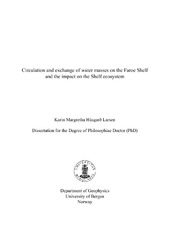| dc.contributor.author | Larsen, Karin Margretha Húsgarð | eng |
| dc.date.accessioned | 2009-09-10T11:24:57Z | |
| dc.date.available | 2009-09-10T11:24:57Z | |
| dc.date.issued | 2009-02-11 | eng |
| dc.identifier.isbn | 978-82-308-0737-8 (print version) | en_US |
| dc.identifier.uri | https://hdl.handle.net/1956/3449 | |
| dc.description.abstract | The findings in this work can be listed as follows: FSW: Based on CTD data, the FSW is found to be relatively vertically homogeneous through-out the year inside the 100 m depth contour. Temperature measurements at coastal stations reveal that the FSW is also horizontally homogeneous especially in the central and northern part of the Shelf. The southern part can become isolated from the rest of the Shelf during winter. Temperature disturbances originate mainly at the offshelf boundaries and are transmitted to the inner shelf. The seasonal range in temperature is approximately 4 °C. From a coastal station and a standard CTD station on the Shelf, the FSW is found to be fairly homogeneous in salinity too, with a seasonal range on the order of 0.1. Tidal currents are strong and predominantly semidiurnal. The residual currents follow the topography in a clockwise manner and are on the order of 10 cm s-¹. A correlation and regression analysis verifies that the residual circulation can be generated by tidal rectification. A seasonal variation in the residual current is found in two out of five sites. FSF: The FSF experiences a seasonal variation such that it has the largest cross-frontal temperature difference (~2 °C) in spring induced by effective atmospheric cooling over the shallow shelf during winter. The temperature difference is maintained, although diminished, during summer, and the lowest temperature differences are observed in autumn. During a short period in autumn, the cross-frontal temperature difference is close to zero and may occasionally be reversed, so that the on-shelf water becomes slightly lighter than the off-shelf water. Salinity differences experience a small seasonal variation on the order of 0.1. Density differences are, therefore, mainly determined by temperature variations. The bottom depth where the centre of the FSF is observed, varies around the Shelf, and increases from east through north to the west and south. Tidal currents determine the location of the FSF and the theoretically predicted location of the front (Soulsby, 1983) fits fairly well with the observed location. The tilting angle of the front during spring is found to be on the order of 0.02 and in near geostrophic balance. The tilt induces a bottom contact some 5 km farther offshelf compared to the surface expression. Exchange: The typical exchange rate of FSW is found to be equivalent to a turbulent diffusivity of 67 m² s-¹, estimated using a temperature and a salinity budget. Indications in temperature and salinity observations reveal that the exchange rate is highly variable and typically varies by a factor of five. Continuous exchange through the front can be achieved through advection and turbulent diffusion. The associated on-shelf advection of an off-shelf transport in the bottom Ekman layer is found to be large enough to supply the heat needed to maintain the front in a quasistationary balance during spring. Extreme exchange is likely to be induced by episodic exchange events. Two extreme exchange processes are indicated: cascading through a canyon and an extreme intrusion of off-shelf water into coastal waters. The importance of these processes is uncertain. Biological impact: The relationship between the primary production on the Shelf and the magnitude of the exchange rate was investigated using a PP-model. When the exchange rate is small, the plankton is mainly confined to the FSW, and a strong spring bloom develops. If the exchange rate is high, the plankton is exported off the Shelf, delaying the spring bloom by up to three weeks. This is a general relationship and may be important for other island or bank systems, as well. With updated observational material, the hypothesised relationship between the primary production and the physical parameters is still found to be statistically significant. Years with an intensive spring blooms, thus, seem to occur when there is a large density difference across the front due to strong winter cooling. | en_US |
| dc.language.iso | eng | eng |
| dc.publisher | The University of Bergen | en_US |
| dc.relation.haspart | Paper I: Journal of Marine Systems 56(3–4), Eliasen, S. K.; Gaard, E.; Hansen, B.; Larsen, K. M. H., A ‘‘horizontal Sverdrup mechanism’’ may control the spring bloom around small oceanic islands and over banks, pp. 352-362. Copyright 2005 Elsevier B.V. Full text not available in BORA due to publisher restrictions. The published version is available at: <a href="http://dx.doi.org/10.1016/j.jmarsys.2005.03.005" target="blank"> http://dx.doi.org/10.1016/j.jmarsys.2005.03.005</a> | en_US |
| dc.relation.haspart | Paper II: ICES Journal of Marine Science 62(7), Hansen, B.; Eliasen, S. K.; Gaard, E.; Larsen, K. M. H., Climatic effects on plankton and productivity on the Faroe Shelf, pp. 1224-1232. Copyright 2005 International Council for the Exploration of the Sea. Published by Elsevier Ltd. Full text not available in BORA due to publisher restrictions. The published version is available at: <a href="http://dx.doi.org/10.1016/j.icesjms.2005.04.014" target="blank">http://dx.doi.org/10.1016/j.icesjms.2005.04.014</a> | en_US |
| dc.relation.haspart | Paper III: Continental Shelf Research 28(14), Larsen, K. M. H.; Hansen, B.; Svendsen, H., Faroe Shelf Water, pp. 1754-1768. Copyright 2008 Elsevier Ltd. Full text not available in BORA due to publisher restrictions. The published version is available at: <a href="http://dx.doi.org/10.1016/j.csr.2008.04.006" target="blank"> http://dx.doi.org/10.1016/j.csr.2008.04.006</a> | en_US |
| dc.relation.haspart | Paper IV: Journal of Marine Systems 78(1), Larsen, K. M. H.; Hansen, B.; Svendsen, H., The Faroe Shelf Front: Properties and exchange, pp. 9-17. Copyright 2009 Elsevier B.V. Full text not available in BORA. The published version is available at: <a href="http://dx.doi.org/10.1016/j.jmarsys.2009.02.003" target="blank">http://dx.doi.org/10.1016/j.jmarsys.2009.02.003</a> | en_US |
| dc.title | Circulation and exchange of water masses on the Faroe Shelf and the impact on the Shelf ecosystem | en_US |
| dc.type | Doctoral thesis | |
| dc.rights.holder | Karin Margretha Húsgarð Larsen | en_US |
| dc.subject.nsi | VDP::Matematikk og Naturvitenskap: 400::Geofag: 450::Oseanografi: 452 | nob |
